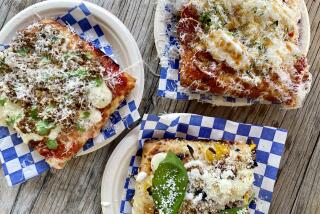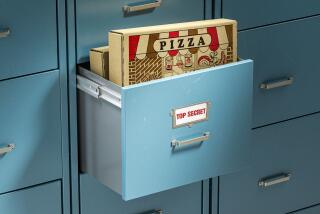Pizza: the Simpler, the Better
A basic bread dough: flour, water and yeast. A main ingredient--maybe nothing more than a couple of tomatoes. A little bit of cheese.
There’s not much that’s simpler than pizza, which makes it all the more unusual that people hold so many strong opinions about it. There are more schisms among pizza aficionados than among Southern Baptists.
Although the fundamental article of faith is the same, you know who they say lives in the details. You’ve got your deep-dishers and your flat-panners, your thick-crusters and your thin-crusters, your saucers and your no-saucers (wet and dry?).
And then of course there’s the fire. There are those who believe that no pizza worthy of serious consideration can come from a gas-fired oven, and even they are divided as to the source of the true flame--wood or coal.
A friend in New York once got so wrapped up in the whole debate that he spent days poring over old maps of the city, trying to determine where the first pizza oven was located and which among the current ones is the oldest.
Of course, he’s also the guy who insisted I eat at a place called Napoli 45 in Grand Central Station, because they import everything from Naples--the flour, even the water. (The crust was indeed outstanding; the pizza itself was good but not great.)
My friend would probably sneer, but I must tell you that the best pizza I’ve had in years--maybe as good as any I’ve had--is one I ate a couple of weeks ago in Phoenix.
Now, Phoenix is not the first place you think of when someone mentions great food, or even the second or third. It’s also not the most likely spot to find an authentic Italian pizzeria.
But there it is, Pizzeria Bianco, the busiest place in a rather forlorn bit of urban renewal called Heritage Square, just east of the convention center. A simple, square room that might hold 50 for dinner if everyone had skipped lunch, Pizzeria Bianco is the domain of Chris Bianco, a 36-year-old chef from the Bronx, who makes every pizza sold, every day at every meal. Even with a roomful of foodies, he never left the kitchen to schmooze. How refreshing.
As becomes a pizza cook, Bianco is a great believer in simplicity. There are only four pizzas on the menu, plus three or four salads. At dinner, there’s one antipasto--vegetables roasted in the pizza oven, doused with good olive oil and served with hard salami and cheese.
Through an accident of fate and/or bad planning, I found myself eating three meals in a row at Pizzeria Bianco, and rather than getting bored by the limited selection, I found myself looking forward to it.
In fact, after having been home for a couple of days, I found myself longing for a Bianco pizza. Two I especially like: One, called Rosa, is an unlikely sounding combination of thinly sliced red onions, crushed pistachios and a little Grana Padano.
This is not some nouvelle affectation; it’s based on a pizza Bianco ate in Liguria, where they used pine nuts or sesame seeds in place of the pistachios. Too often the pine nuts and sesame seeds Bianco could get in Phoenix were rancid, so he substituted pistachios.
The other, Biancoverde, also from Liguria, is even simpler--a light pasting of cheese that is baked until blistering and topped at the last minute with a scattering of fresh arugula, which gives off an intense herbal perfume. The sweet, soft cheese, the peppery arugula, the crisp crust. . . . Rarely do such basic ingredients combine so well.
Pizzas are easy to do at home, but there are a couple of things to think about.
* First, the dough for the crust should be somewhat wetter than you might normally use for baking bread. This will make a thinner, crisper crust. If it seems a little too wet after mixing, that’s probably just right. The excess moisture will be absorbed during the rise.
* The absolute best way to bake a pizza is on stone. You can buy specially made pizza stones, but unglazed quarry tiles that you pick up at the hardware store work just as well. Put the stone or the tiles on the lowest rack and then preheat the oven at the highest possible temperature for at least 30 minutes. Don’t put the stone or tiles on the floor of the oven, though. They’ll get too hot and you’ll end up with a scorched crust.
* The best way to build a pizza is to place the rolled-out dough on a well-floured wooden pizza paddle, or peel. I like to use cornmeal--it adds a nice crunch to the crust--but some purists frown on this.
* Add any flavoring ingredients and then the cheeses--a light hand is a must for both, especially if you’re working with a thin crust. Just remember to think of it as bread with a flavoring, rather than vice versa.
* Transfer the pizza to the oven by placing the peel on the stone and giving a quick forward thrust to get the crust moving in the right direction, then immediately jerk the paddle out from underneath.
That’s all there is to it. And short of flying to Phoenix--or Genoa--you’ll be hard pressed to find a better pizza.
Unless you’re a heretic thick-cruster, deep-disher or saucer, that is.
Chris Bianco’s Pizza Biancoverde
Active Work Time: 15 minutes * Total Preparation Time: 1 hour
You can expand the rise of the pizza dough by at least an hour to get a fuller bread flavor. Punch it down and set it aside in a mixing bowl covered with a damp cloth.
3 cups flour
1 cup water, room temperature
1 (1/4-ounce) package dry yeast
Salt
2/3 cup ricotta
6 tablespoons Grana Padano or Parmigiano Reggiano
1/2 pound fresh mozzarella, cubed
1 bunch arugula, leaves and tender stems only
* Combine flour, water, yeast and 1 teaspoon salt in large bowl and mix either by hand or mixer until fairly sticky dough forms. If dough is too slack, add up to 1/2 cup flour. If dough is tight and dry, add more water, 1 tablespoon at a time. Form dough into ball, cover with towel and let sit at least 30 minutes.
* Cut dough ball in half and press each half into disk shape. Form crusts either by rolling with rolling pin, always rolling outward from center of dough, or tossing in air and spinning to stretch. Finish by hand, forming slight rim to keep moist ingredients on pizza.
* Place disks on heavy baking sheet. Spread 1/3 cup ricotta lightly over top of each. Sprinkle each with 3 tablespoons Grana Padano and dot with half of mozzarella. Bake at 500 degrees on lowest rack until crust is browned and cheese begins to bubble, 10 to 15 minutes.
* Remove from oven, sprinkle lightly with salt and then strew with arugula. Serve immediately.
2 pizzas, each serving 4. Each serving: 297 calories; 507 mg sodium; 36 mg cholesterol; 11 grams fat; 35 grams carbohydrates; 15 grams protein; 0.15 gram fiber.
More to Read
Eat your way across L.A.
Get our weekly Tasting Notes newsletter for reviews, news and more.
You may occasionally receive promotional content from the Los Angeles Times.











